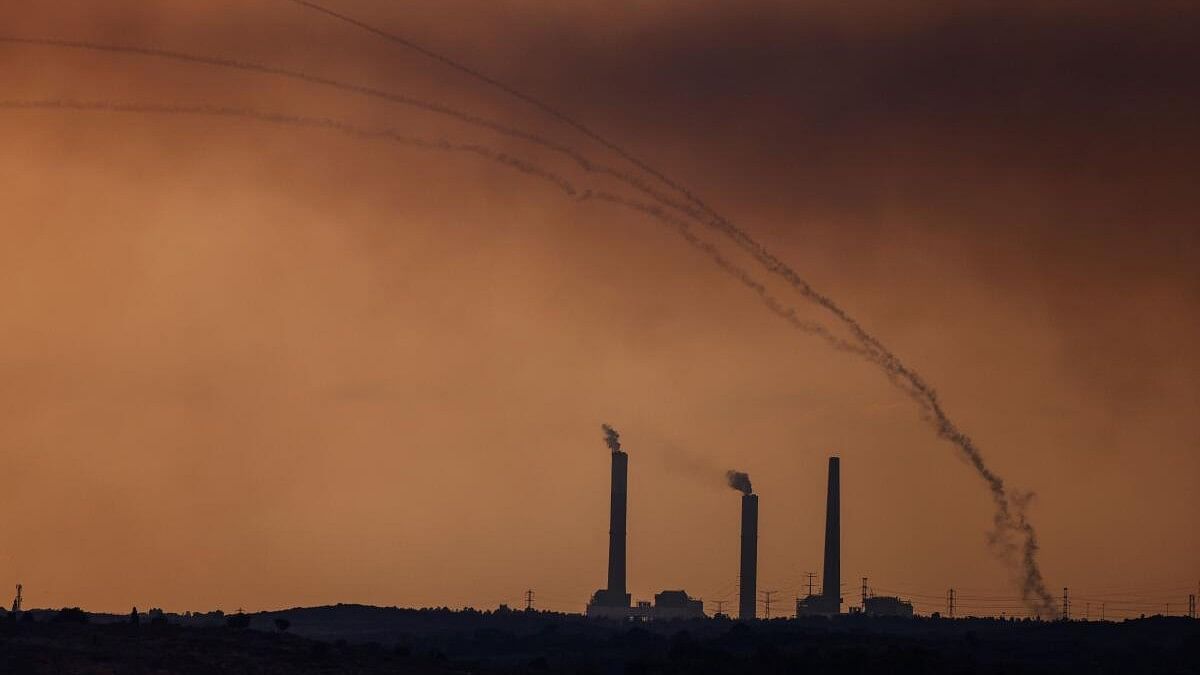
Israel's Iron Dome anti-missile system intercepts rockets launched from the Gaza Strip, as seen from the Israeli side of the border between Israel and the Gaza Strip on October 9, 2023.
Credit: Reuters/Amir Cohen
“This is our 9/11," Major Nir Dinar, spokesperson for the Israeli Defence Forces said in the aftermath of Hamas’ massive ambush into the country in which at least 700 people were killed and left over 2000 others injured.
"They got us," Dinar conceded.
The ghastly attacks have put the spotlight on the failure of the famed Israeli intelligence system with questions being raised as to how an ambush on such a massive scale was planned and executed without anyone getting a sniff of it.
The land attack from Hamas militants was accompanied by the launch of thousands of rockets into Israel territory from Gaza. The attack has again brought the limelight back to the Iron Dome, Israel’s much-hyped air defence system.
The Iron Dome intercepts enemy missiles and other aerial threats mid-air and as per the state government has an astounding success rate of 90 per cent.
The Iron Dome has symbolised Israel’s outstanding defence capabilities since 2011, the year it was brought into operation.
However, after being at the receiving end of this elite air defence system over the years, Israel’s enemies have started to find loopholes in it. In recent conflicts, Hamas, which controls the Gaza strip, has shown how this system, which seems impregnable, is not exactly that.
How Hamas got the better of the Iron Dome on October 7
Before the current attack, the last Israel-Palestine conflict took place in 2021. Seth J Frantzman, the author of Drone Wars: Pioneers, Killing Machines, Artificial Intelligence, and the Battle for the Future, wrote at the time in the Foreign Policy about the change in the strategy of Hamas and how it was exposing the chinks in Israel’s air defence.
“Hamas used massive barrages of rockets in a new way, apparently designed to test or attempt to overwhelm the Iron Dome systems… In several barrages, up to 140 rockets were fired in several minutes,” he wrote.
“The message after the war is that Israel's air defenses may one day not be enough to hinder volumes of rockets. Israel won’t admit this, but there is a strategic peak for this technology,” analysed Frantzman.
On October 7, Hamas used the same strategy and increased the volume of these rockets immensely, testing the limits of the Israeli air defence systems. The Islamist group, according to an NDTV report, fired around 5,000 rockets in just 20 minutes, overwhelming the famed Iron Dome. With this unprecedented heavy firing, the group was able to land rockets in places as far away as Tel Aviv and the outskirts of Jerusalem, which are rarely hit by Hamas rockets due to the Iron Dome, reported The New York Times.
The cost factor
Also, with the barrage of rockets, Hamas hits Israel financially as their rockets cost almost nothing when compared to the intercepting missiles of the Israeli air defence system.
According to a Forbes report, Hamas’ traditional weapon, the Qassam rocket, is a cheap garage-built weapon. This weapon is assembled from industrial piping, home-made rocket fuel of sugar and potassium nitrate fertilizer, and commercial explosive.
Israeli daily, Jerusalem Post newspaper quoted Uzi Rubin, who is considered as one of the fathers of Israeli missile defence, as saying that the cost of the short-range Qassam rocket fired by Hamas would be somewhere between $300 and $800 each.
The cost of each intercepting missile from the Iron Dome is about $40,000 to $50,000, Bloomberg reported, quoting Israel's Institute for National Security Studies. Some reports even put the estimate to $100,000 per missile.
So, even when Hamas' rockets are not striking Israeli targets, they are hitting the finances of the country hard.